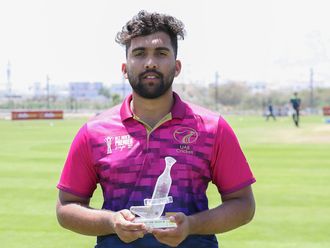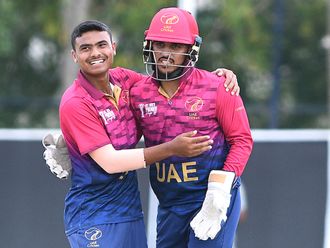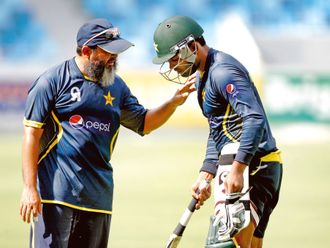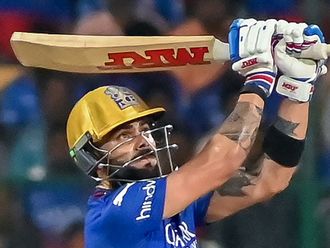London: Every now and then — perhaps once a decade on average — an England batsman surfaces, one who is destined for a long and distinguished career. Joe Root was the last, Alastair Cook the one before him, and the next seems to be the 19-year-old Haseeb Hameed. Nobody at Lancashire doubts that Hameed has what it takes — those three Ts of talent, technique and temperament.
The question is whether he is being thrown into the deep end too soon as Cook’s opening partner in place of Alex Hales. If Haseeb swims next month in Bangladesh, he will be the youngest England batsman since Denis Compton, and could play seven Tests before the age of 20.
The essence of Hameed’s cricket, which singles him out as a worthwhile punt, is that he has always made a speciality out of being thrown in at the deep end and swimming buoyantly. His brain has been programmed to bat, thanks to his upbringing at home in Bolton. His father, Esmail, was a self-taught cricketer who played in the Bolton Assocation league, after emigrating from Gujarat.
Esmail copied Geoffrey Boycott’s defence, to the point he was nicknamed Geoffrey, and Ian Chappell’s hooking. By profession, having worked in textiles, he was a driving instructor — then became a cutting and pulling instructor for his youngest son.
“Even now, I can picture myself in the living room with the TV to my left and my dad sitting on the sofa right in front of me and throwing balls at me,” Hameed recalled. “I’d play a few shots into the sofas, then I’d end up breaking something and there’d be a bit of a hoo-ha, but my mum never told me to stop playing. That was one of my best memories growing up as a child, playing in that living room, because that was the starting point I guess of my passion for cricket.”
He reckons he was pestering his dad to bowl from the age of four. A mark of Hameed’s red-ball batting is how he keeps the ball on the ground.
“I don’t remember being told to keep the ball down, but it’s a pretty natural thing to do if you’ve got things on the wall [in the living room]. I also remember I’d have a bat in one hand and throw the ball at the wall and do drills like giving myself room to drive over extra-cover.”
The phenomenon of swimming in the deep end began in his first game of formal cricket. His two elder brothers played for Tong CC in Bolton, and their under-15s were short. Hameed was drafted in aged 8. He top scored with 19 not out. “That was a massive thing for me, not to lose my wicket, not to get bowled out by the under-15s,” Hameed said.
“I got 22 not out the week after, so that was progress again. The thing for me at that age was I absolutely loved it, though I can’t remember myself being much bigger than the stumps.
“I come from a cricket-mad family and I’ve always wanted to play cricket at the highest level and always had aspirations of making it big in some way,” Hameed said.
Tong’s coach, John Roberts, who had played a few games for Somerset, recommended the little lad to Lancashire.
“I’m pretty sure I got into Lancs at the age of nine predominantly as a leg-spinner because I started batting quite low and I got quite a few wickets. I think the turning point came about when we played Warwickshire Under-11s, who hadn’t been beaten for two years, and I was able to get 48 not out at seven or eight after we’d had a little collapse to see us home. We needed one off the last ball and I dropped it down to cover and ran. I was able to show I could bat as well when the coaches maybe thought I was a little bit too small — because you see me now and I’m skinny.”
After he had made his first century for Lancashire Under-11s against Kent, the word spread. When he was 12, a letter arrived from Worcestershire. They were ready to invest £100,000 (Dh483,716) in his education by sending him to Malvern College.
“My mum and dad spoke to me about the offer but my heart was always set on playing for Lancs, being a local lad. I ended up going to Bolton School [Lancashire shared with the school the cost of his scholarship] which helped my development in that they played a lot more competitive cricket than my other school, and we had quite a strong side, with Matthew Parkinson, who’s on the staff here [at Lancashire].”
Not wanting to compete with Parkinson, who is a leg-spinner, Hameed now works on off-spin to augment his batting — just like his role-model Joe Root. His England Under-19 Test debut against Australia — his first four-day game — illustrated this same phenomenon. After Hameed made a duck, England were almost 300 behind on first innings and had two days to bat out for a draw at the Waca in Perth.
“I remember keeping it dead simple in terms of my game-plan — no driving the ball till it’s right up there because you’ve got to minimise risk, then after a while your instinct takes over and it comes more natural.”
He ended day three on 91 not out, off 256 balls, and was ready to battle on when rain washed out day four. His other main experience overseas, which is highly relevant, has been in Mumbai on a couple of family visits.
“I trained at some decent academies where the quality of bowling was high,” he said. But his lessons against spin had begun long before: “Again that started at a young age in the front garden. Dad would flick his fingers, and we had a ridge on middle-and-leg so the rubber ball turned pretty sharply and, if it’s turning and bouncing, you’ve got to learn how to judge length.”
He has such a settled temperament,” the father said of ‘Has’ as he is known.
“He just gets it,” said Ashley Giles, Lancashire’s coach.
Last week Hameed gave up short-leg because Lancashire had a new batsman, Rob Jones, to do it. Then Giles told Hameed he would have to field at short-leg for England, being the youngest, so next morning it was back to work under the helmet. It seems too good to be true for England to unearth two great batsmen so close together, assuming Root is emulated by Hameed. But Denis Compton and Len Hutton came along at exactly the same time.










